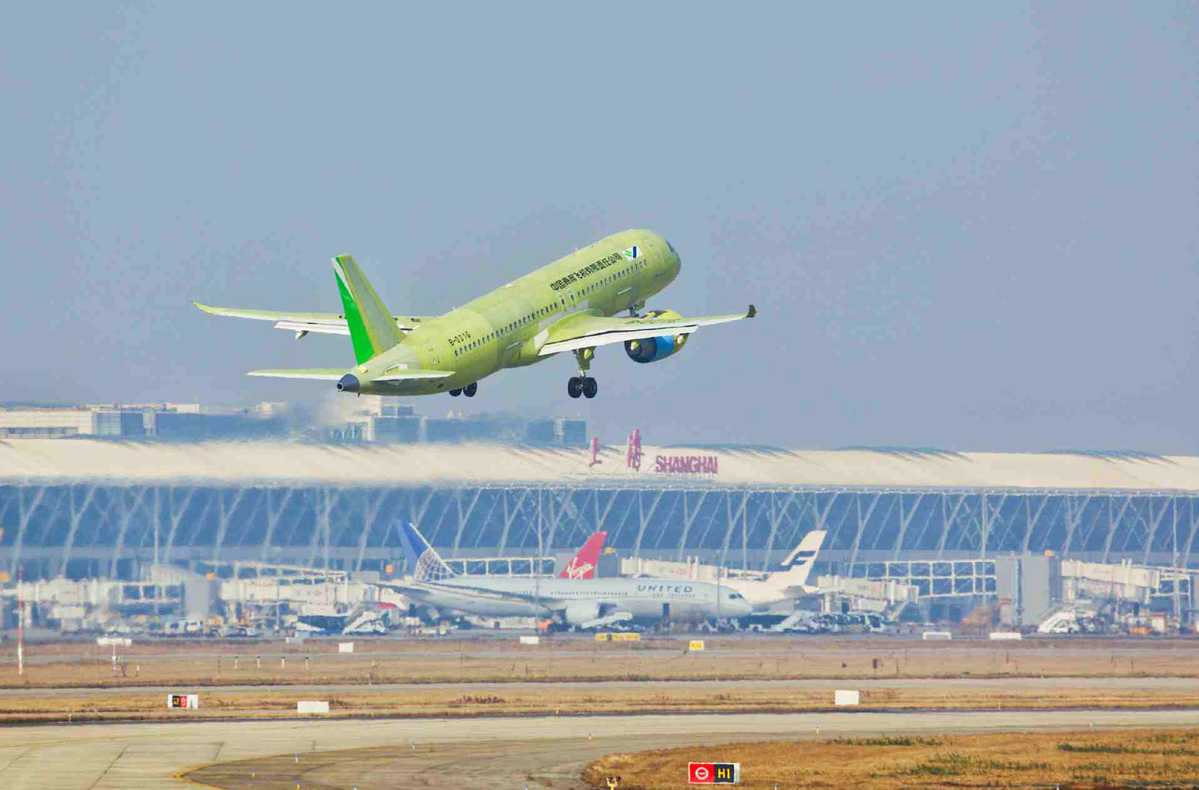


A C919 takes off at Shanghai Pudong International Airport on Dec 27, 2019. [Photo/Xinhua]
Blueprint for development envisions network for transport across region
China is set to create a world-class airfield complex across the Yangtze River Delta region, according to a blueprint issued by the National Development and Reform Commission on Monday.
The blueprint, focused on high-quality integrated development of the region's transportation by 2025 and published on the NDRC's website, lays a solid foundation to improve the area's infrastructure and supports the integrated development of the area and the nation's economic growth.
According to the blueprint, a number of major projects will be rolled out across the region, including new airports in Jiaxing and Lishui of Zhejiang province, as well as in Wuhu, Bozhou, Bengbu, Suzhou and Chuzhou of Anhui province.
In addition, the blueprint suggests the Yangtze River Delta region better adapt to the international trading environment and global supply chain, improve its airport network and optimize its ports' ability to coordinate.
"The new situation requires the region to better cope with the new international division of labor and better serve the State development strategy; better support and lead the economic mapping and adjustment of the regional population; better promote the construction of a modern industry system and coordination among industries; better explore a new way of eco-first and eco-friendly development; and better master the world's new round of science and technology revolution as well as the latest trend of industry transformation," the blueprint stated.
"The Yangtze River Delta region has already formed an effective transportation network of airports, seaports, railways and roads that have greatly improved the region's attraction in the past few decades, and that is the foundation for future planning and development," said Zhu Ronglin, a regional planning expert from the Development Research Center of the State Council and the NDRC.
Currently, travel between major cities across the region can be accomplished within 1.5 hours, and multiple transportation facilities enable goods to be shipped professionally across the region, according to the guideline.
But in accordance with higher standards of integration, there is still room for the region's transportation system to be improved, such as in the coordination of ports and airports, the service of the Shanghai international shipping center and cross-regional planning and operations.
"A highly efficient network requires closer connection between various transportation tools. That takes comprehensive planning to get different transportation solutions to work together, either for cargo delivery or for passenger travel," said Chen Zhuo, a senior analyst with China Merchants Securities.
Despite the region's outstanding transportation facilities among all city clusters across the nation, the further integration of the Yangtze River Delta region calls for a world-class airfield complex to support transportation from the region to across China and the world, said Yu Hongsheng, a researcher with Shanghai Academy of Social Sciences.
According to Yu, the existing 20-plus airports in the region can hardly meet the demand for air travel for its 300 million people.
"The significance of aviation will be key for China as the nation becomes more and more international and further opens up its economy," Yu said.
Zhu suggested the development of an airfield complex should avoid homogeneous competition to make sure the airports are under coordinated management.
"Different airports should have their own clear function and positioning to differentiate one from another. In the meantime, their management must be well-coordinated, so that aviation transportation can work at high efficiency," Zhu said.
"The high efficiency of the integrated airfield complex is key for the region's economic development and business vitality. Therefore, a fine concrete plan from the central government is extremely important," Yu said.
 Fire brigade in Shanghai holds group wedding
Fire brigade in Shanghai holds group wedding Tourists enjoy ice sculptures in Datan Town, north China
Tourists enjoy ice sculptures in Datan Town, north China Sunset scenery of Dayan Pagoda in Xi'an
Sunset scenery of Dayan Pagoda in Xi'an Tourists have fun at scenic spot in Nanlong Town, NW China
Tourists have fun at scenic spot in Nanlong Town, NW China Harbin attracts tourists by making best use of ice in winter
Harbin attracts tourists by making best use of ice in winter In pics: FIS Alpine Ski Women's World Cup Slalom
In pics: FIS Alpine Ski Women's World Cup Slalom Black-necked cranes rest at reservoir in Lhunzhub County, Lhasa
Black-necked cranes rest at reservoir in Lhunzhub County, Lhasa China's FAST telescope will be available to foreign scientists in April
China's FAST telescope will be available to foreign scientists in April "She power" plays indispensable role in poverty alleviation
"She power" plays indispensable role in poverty alleviation Top 10 world news events of People's Daily in 2020
Top 10 world news events of People's Daily in 2020 Top 10 China news events of People's Daily in 2020
Top 10 China news events of People's Daily in 2020 Top 10 media buzzwords of 2020
Top 10 media buzzwords of 2020 Year-ender:10 major tourism stories of 2020
Year-ender:10 major tourism stories of 2020 No interference in Venezuelan issues
No interference in Venezuelan issues
 Biz prepares for trade spat
Biz prepares for trade spat
 Broadcasting Continent
Broadcasting Continent Australia wins Chinese CEOs as US loses
Australia wins Chinese CEOs as US loses